Reactive Compatibilization of PLA/PA11 Blends and Their Application in Additive Manufacturing
Abstract
1. Introduction
2. Materials and Methods
2.1. Materials
2.2. Blend Preparation
2.3. Standard Samples Preparation
2.4. Morphological Characterizations
2.4.1. Scanning Electron Microscopy (SEM)
2.4.2. Selective Extraction
2.4.3. Laser Diffraction Particle Size Analyzer
2.5. Differential Scanning Calorimetry (DSC)
2.6. Rheological Tests
2.7. Tensile Tests
2.8. Porosity Measurement
3. Results and Discussion
3.1. Effects of Joncryl on Blends Morphology and Properties
3.1.1. Blends Morphology
3.1.2. Thermal Properties and Crystallinity
3.1.3. Rheological Behavior
3.2. Comparison Between Injected and FDM Samples Morphology and Mechanical Properties
3.2.1. FDM Filaments and Dog Bone Shaped Samples Morphology
3.2.2. Mechanical Properties
- For 0≤ x ≤ 1.5: PA11 dispersed phases extend individually but not PLA matrix, because of its intrinsic brittle behavior and owing to the lack of interfacial adhesion, leading to a clear brittle failure.
- For x = 2 or 3: PA11 dispersed phases extend with PLA matrix and form an elongated structure, leading to a ductile failure.
3.2.3. Printed Samples Morphology and Porosity
4. Conclusions
Supplementary Materials
Author Contributions
Funding
Acknowledgments
Conflicts of Interest
References
- Anderson, K.S.; Hillmyer, M.A. The influence of block copolymer microstructure on the toughness of compatibilized polylactide/polyethylene blends. Polymer (Guildf) 2004, 45, 8809–8823. [Google Scholar] [CrossRef]
- Kim, Y.F.; Choi, C.N.; Kim, Y.D.; Lee, K.Y.; Lee, M.S. Compatibilization of immiscible poly(l-lactide) and low density polyethylene blends. Fibers Polym. 2004, 5, 270–274. [Google Scholar] [CrossRef]
- Choudhary, P.; Mohanty, S.; Kayak, S.K.; Unnikrishnan, L. Poly(l-lactide)/Polypropylene Blends: Evaluation of Mechanical, Thermal, and Morphological Characteristics. J. Appl. Polym. Sci. 2011, 121, 3223–3237. [Google Scholar] [CrossRef]
- Han, J.-J.; Huang, H.-X. Preparation and characterization of biodegradable polylactide/thermoplastic polyurethane elastomer blends. J. Appl. Polym. Sci. 2011, 120, 3217–3223. [Google Scholar] [CrossRef]
- Broz, M.E.; VanderHart, D.L.; Washburn, N.R. Structure and mechanical properties of poly(d,l-lactic acid)/poly(ε-caprolactone) blends. Biomaterials 2003, 24, 4181–4190. [Google Scholar] [CrossRef]
- Yeh, J.-T.; Tsou, C.-H.; Huang, C.-Y.; Chen, K.-N.; Wu, C.-S.; Chai, W.-L. Compatible and crystallization properties of poly(lactic acid)/poly(butylene adipate-co-terephthalate) blends. J. Appl. Polym. Sci. 2009, 116, 680–687. [Google Scholar] [CrossRef]
- Chen, G.X.; Kim, H.S.; Kim, E.S.; Yoon, J.S. Compatibilization-like effect of reactive organoclay on the poly(l-lactide)/poly(butylene succinate) blends. Polymer (Guildf) 2005, 46, 11829–11836. [Google Scholar] [CrossRef]
- Deng, Y.; Thomas, N.L. Blending poly(butylene succinate) with poly(lactic acid): Ductility and phase inversion effects. Eur. Polym. J. 2015, 71, 534–546. [Google Scholar] [CrossRef]
- Signori, F.; Coltelli, M.-B.; Bronco, S. Thermal degradation of poly(lactic acid) (PLA) and poly(butylene adipate-co-terephthalate) (PBAT) and their blends upon melt processing. Polym. Degrad. Stab. 2009, 94, 74–82. [Google Scholar] [CrossRef]
- Koning, C.; Van Dui, M.; Pagnoulle, C.; Jerome, R. Strategies for Compatibilization of Polymer Blends. Prog. Polym. Sci. 1998, 23, 707–757. [Google Scholar] [CrossRef]
- Pillon, L.Z.; Utracki, L.A. Compatibilization of polyester/polyamide blends via catalytic ester-amide interchange reaction. Polym. Eng. Sci. 1984, 24, 1300–1305. [Google Scholar] [CrossRef]
- Feng, F.; Ye, L. Structure and Property of Polylactide/Polyamide Blends. J. Macromol. Sci. Part B 2010, 49, 1117–1127. [Google Scholar] [CrossRef]
- Meshchankina, M.Y.; Kuznetsova, Y.A.; Shcherbina, M.A.; Chvalun, S.N. Biodegradable blends obtained via reactive blending of polylactide and polyamide-6. Polym. Sci. Ser. B 2016, 58, 214–225. [Google Scholar] [CrossRef]
- Utracki, L.A.; Catani, A.M.; Bata, G.L.; Kamal, M.R.; Tan, V. Melt rheology of blends of semicrystalline polymers. I. Degradation and viscosity of poly(ethylene terephthalate)–polyamide-6,6 mixtures. J. Appl. Polym. Sci. 1982, 27, 1913–1931. [Google Scholar] [CrossRef]
- Retolaza, A.; Eguiazábal, J.I.; Nazábal, J. Structure and mechanical properties of polyamide-6,6/poly(ethylene terephthalate) blends. Polym. Eng. Sci. 2004, 44, 1405–1413. [Google Scholar] [CrossRef]
- Stoclet, G.; Seguela, R.; Lefebvre, J.-M. Morphology, thermal behavior and mechanical properties of binary blends of compatible biosourced polymers: Polylactide/polyamide11. Polymer (Guildf) 2011, 52, 1417–1425. [Google Scholar] [CrossRef]
- Patel, R.; Ruehle, D.A.; Dorgan, J.R.; Halley, P.; Martin, D. Biorenewable blends of polyamide-11 and polylactide. Polym. Eng. Sci. 2014, 54, 1523–1532. [Google Scholar] [CrossRef]
- Heshmati, V.; Zolali, A.M.; Favis, B.D. Morphology development in poly (lactic acid)/polyamide11 biobased blends: Chain mobility and interfacial interactions. Polymer (United Kingdom) 2017, 120, 197–208. [Google Scholar] [CrossRef]
- Gug, J.; Sobkowicz, M.J. Improvement of the mechanical behavior of bioplastic poly(lactic acid)/polyamide blends by reactive compatibilization. J. Appl. Polym. Sci. 2016, 43350, 1–12. [Google Scholar] [CrossRef]
- Dong, W.; Cao, X.; Li, Y. High-performance biosourced poly(lactic acid)/polyamide 11 blends with controlled salami structure. Polym. Int. 2013, 63, 1094–1100. [Google Scholar] [CrossRef]
- Walha, F.; Lamnawar, K.; Maazouz, A.; Jaziri, M. Rheological, Morphological and Mechanical Studies of Sustainably Sourced Polymer Blends Based on Poly(Lactic Acid) and Polyamide 11. Polymers 2016, 8, 61. [Google Scholar] [CrossRef]
- Zolali, A.M.; Favis, B.D. Compatibilization and Toughening of Cocontinuous PLA/PA11 Blend via Controlled Localization of Partially Wet Droplets at the Interface. Polymer (Guildf) 2017, 114, 277–288. [Google Scholar] [CrossRef]
- Patrício, T.; Domingos, M.; Gloria, A.; D’Amora, U.; Coelho, J.F.; Bártolo, P.J. Fabrication and characterisation of PCL and PCL/PLA scaffolds for tissue engineering. Rapid Prototyp. J. 2014, 20, 145–156. [Google Scholar] [CrossRef]
- Serra, T.; Ortiz-Hernandez, M.; Engel, E.; Planell, J.A.; Navarro, M. Relevance of PEG in PLA-based blends for tissue engineering 3D-printed scaffolds. Mater. Sci. Eng. C 2014, 38, 55–62. [Google Scholar] [CrossRef] [PubMed]
- Chen, Q.; Mangadlao, J.D.; Wallat, J.; De Leon, A.; Pokorski, J.K.; Advincula, R.C. 3D Printing Biocompatible Polyurethane/Poly(lactic acid)/Graphene Oxide Nanocomposites: Anisotropic Properties. ACS Appl. Mater. Interfaces 2017, 9, 4015–4023. [Google Scholar] [CrossRef] [PubMed]
- Findrik Balogová, A.; Hudák, R.; Tóth, T.; Schnitzer, M.; Feranc, J.; Bakoš, D.; Živčák, J. Determination of geometrical and viscoelastic properties of PLA/PHB samples made by additive manufacturing for urethral substitution. J. Biotechnol. 2018, 284, 123–130. [Google Scholar] [CrossRef] [PubMed]
- Garcia, V.; Cailloux, J.; Santana, O.; Sanchez-Soto, M.; Carrasco, F.; Maspoch, M. Tailoring PLA/PA bioblends for 3D printing applications via the manufacturing of in situ microfibrillar composite filaments. In Proceedings of the Reunión del Grupo Especializado de Polímeros, Peñíscola, Spain, 15–19 June 2018. [Google Scholar]
- Gonzalez Ausejo, J.; Rydz, J.; Musioł, M.; Sikorska, W.; Janeczek, H.; Sobota, M.; Włodarczyk, J.; Szeluga, U.; Hercog, A.; Kowalczuk, M. Three-dimensional printing of PLA and PLA/PHA dumbbell-shaped specimens of crisscross and transverse patterns as promising materials in emerging application areas: Prediction study. Polym. Degrad. Stab. 2018, 156, 100–110. [Google Scholar] [CrossRef]
- Fischer, E.W.; Sterzel, H.J.; Wegner, G. Investigation of the structure of solution grown crystals of lactide copolymers by means of chemical reactions. Kolloid-Z. Z. Polym. 1973, 251, 980–990. [Google Scholar] [CrossRef]
- Qingxin, Z.; Zhishen, M.; Siyang, L.; Zhang, H. Influence of Annealing on Structure of Nylon 11. Macromolecules 2000, 33, 5999–6005. [Google Scholar]
- Rashmi, B.J.; Prashantha, K.; Lacrampe, M.; Krawczak, P. Toughening of poly(lactic acid) without sacrificing stiffness and strength by melt-blending with polyamide 11 and selective localization of halloysite nanotubes. Express Polym. Lett. 2015, 9, 721–735. [Google Scholar] [CrossRef]
- Najafi, N.; Heuzey, M.C.; Carreau, P.J.; Wood-Adams, P.M. Control of thermal degradation of polylactide (PLA)-clay nanocomposites using chain extenders. Polym. Degrad. Stab. 2012, 97, 554–565. [Google Scholar] [CrossRef]
- Najafi, N.; Heuzey, M.C.; Carreau, P.J. Crystallization behavior and morphology of polylactide and PLA/clay nanocomposites in the presence of chain extenders. Polym. Eng. Sci. 2013, 53, 1053–1064. [Google Scholar] [CrossRef]
- Al-Itry, R.; Lamnawar, K.; Maazouz, A. Improvement of thermal stability, rheological and mechanical properties of PLA, PBAT and their blends by reactive extrusion with functionalized epoxy. Polym. Degrad. Stab. 2012, 97, 1898–1914. [Google Scholar] [CrossRef]
- Wang, Y.; Fu, C.; Luo, Y.; Ruan, C.; Zhang, Y.; Fu, Y. Melt synthesis and characterization of poly(l-lactic acid) chain linked by multifunctional epoxy compound. J. Wuhan Univ. Technol. Sci. Ed. 2010, 25, 774–779. [Google Scholar] [CrossRef]
- Moan, M.; Huitric, J.; Médéric, P.; Jarrin, J. Rheological properties and reactive compatibilization of immiscible polymer blends. J. Rheol. 2000, 44, 1227. [Google Scholar] [CrossRef]
- Aravind, I.; Jose, S.; Ahn, K.H.; Thomas, S. Rheology and morphology of polytrimethylene terephthalate/ethylene propylene diene monomer blends in the presence and absence of a reactive compatibilizer. Polym. Eng. Sci. 2010, 50, 1945–1955. [Google Scholar] [CrossRef]
- Nasrollah Gavgani, J.; Goharpey, F.; Velankar, S.; Foudazi, R. Suppressing droplet coalescence and aggregation in immiscible homopolymer blends by interfacially cross-linked compatibilizers. J. Rheol. 2018, 62, 1217–1231. [Google Scholar] [CrossRef]
- Graebling, D.; Muller, R. Rheological behavior of polydimethylsiloxane/polyoxyethylene blends in the melt. Emulsion model of two viscoelastic liquids. J. Rheol. 1990, 34, 193–205. [Google Scholar] [CrossRef]
- Grace, H.P. Dispersion Phenomena in High Viscosity Immiscible Fluid Systems and Application of Static Mixers as Dispersion Devices in such Systems. Chem. Eng. Commun. 1982, 14, 225–277. [Google Scholar] [CrossRef]
- Van Puyvelde, P.; Moldenaers, P. Rheology and Morphology Development in Immiscible Polymer Blends. Rheol. Rev. 2005, 2005, 101–145. [Google Scholar]
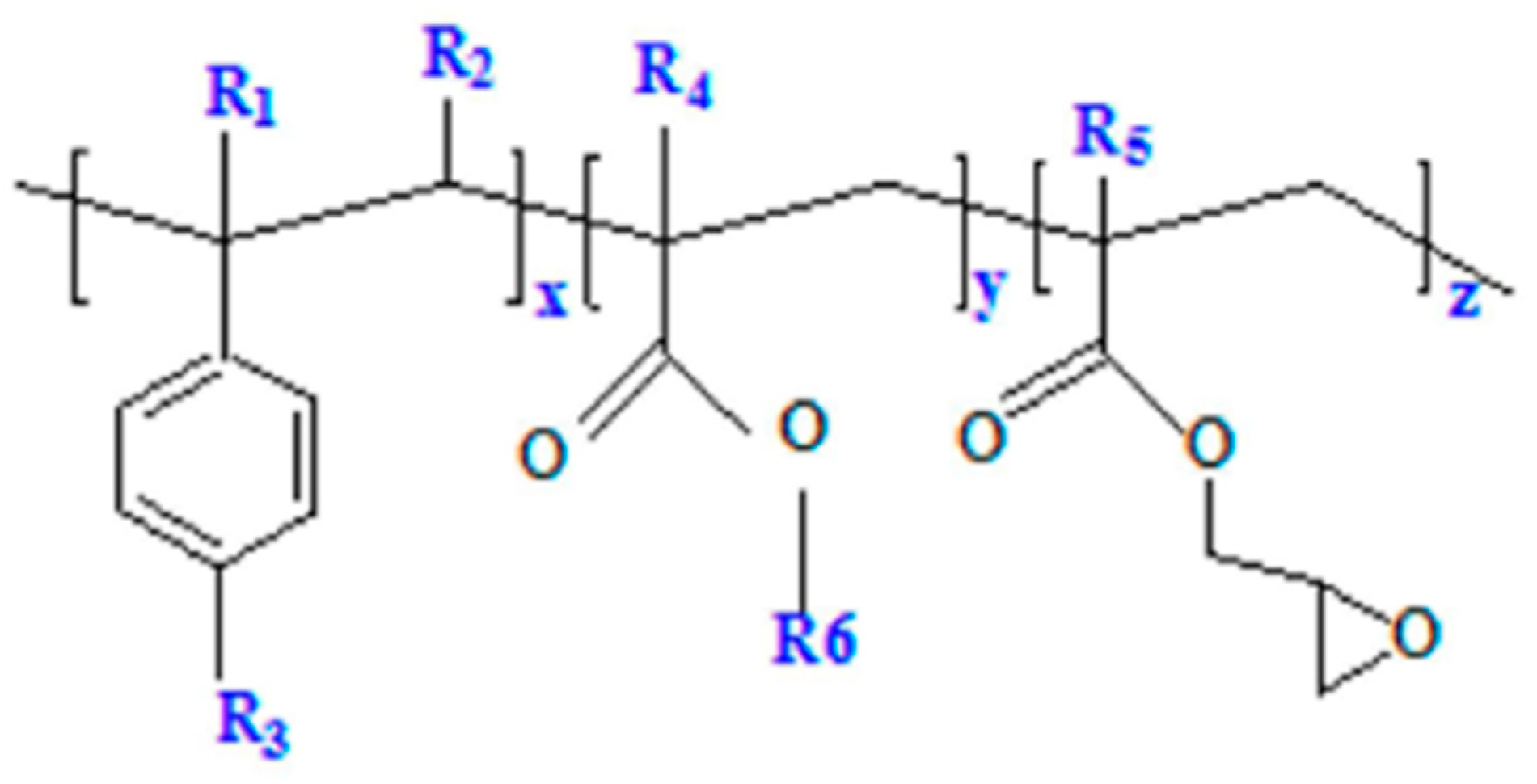
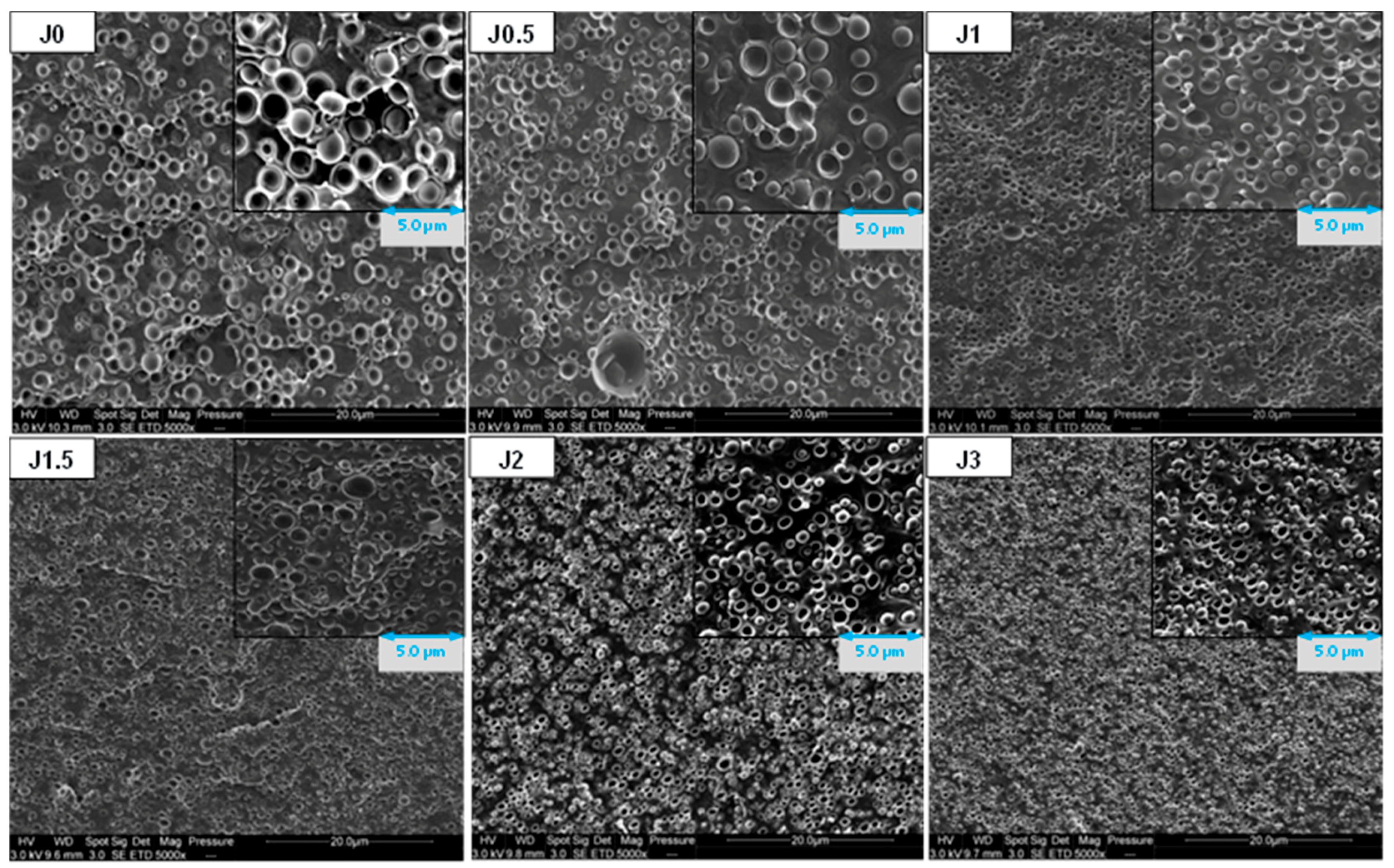

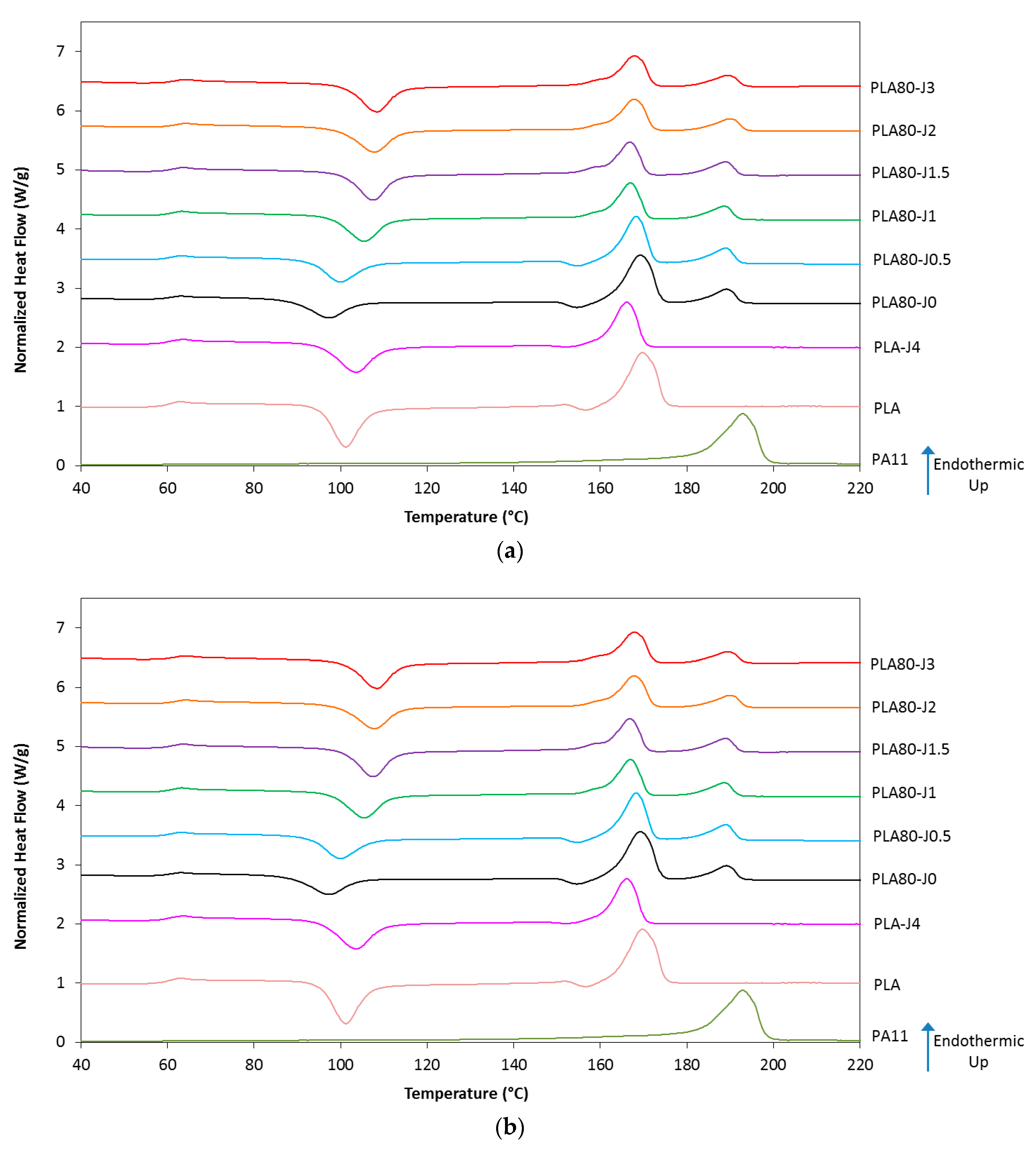
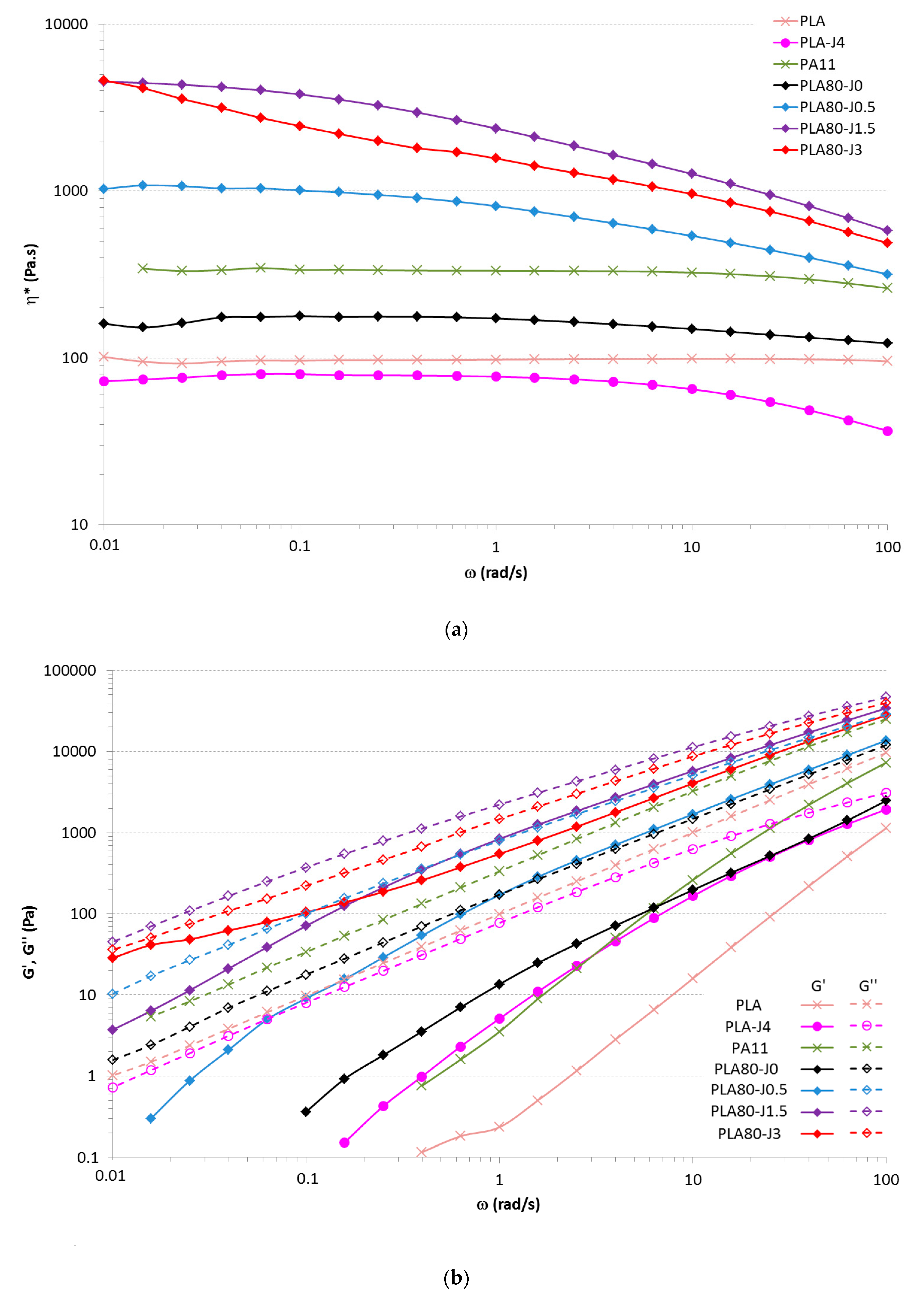
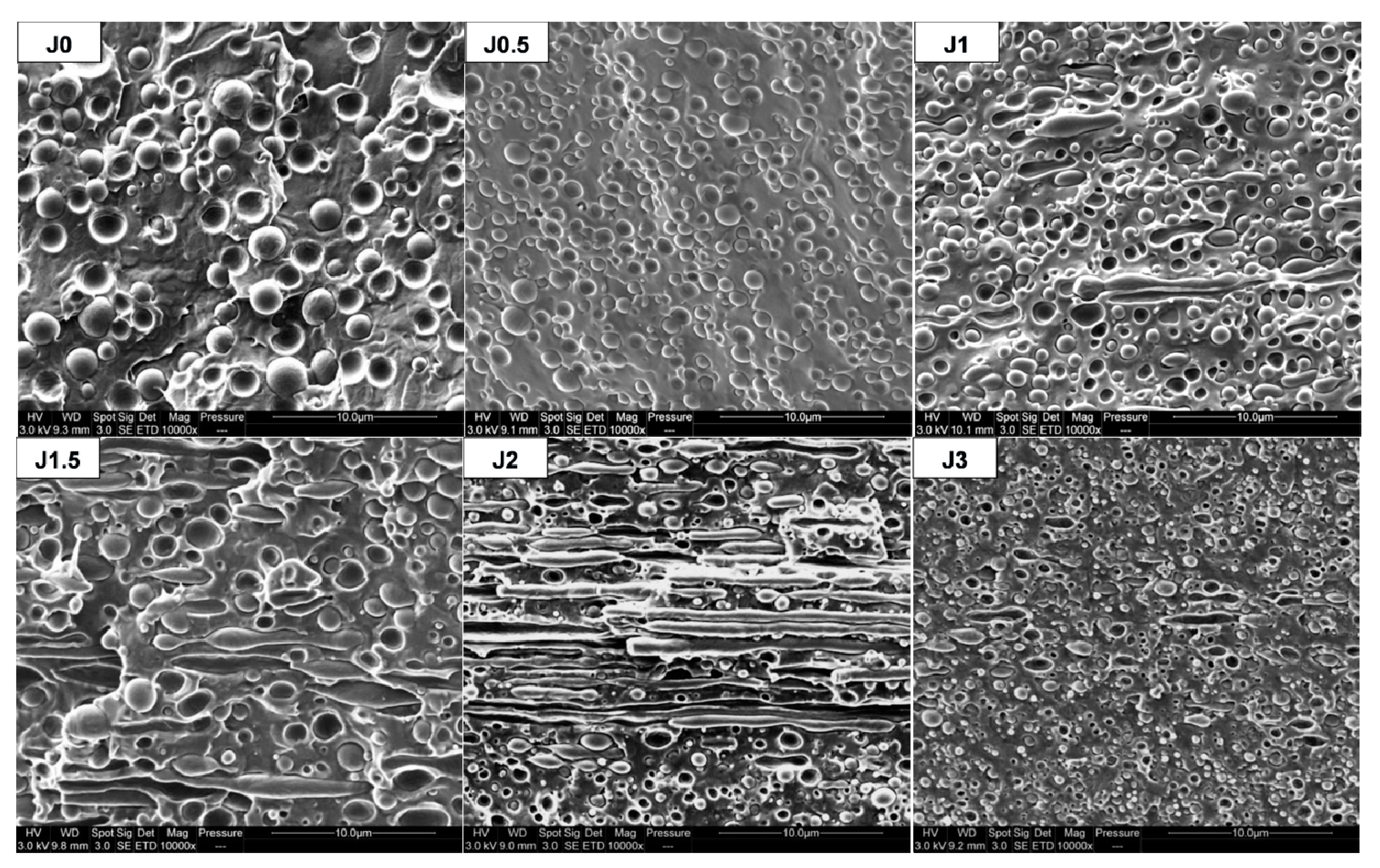
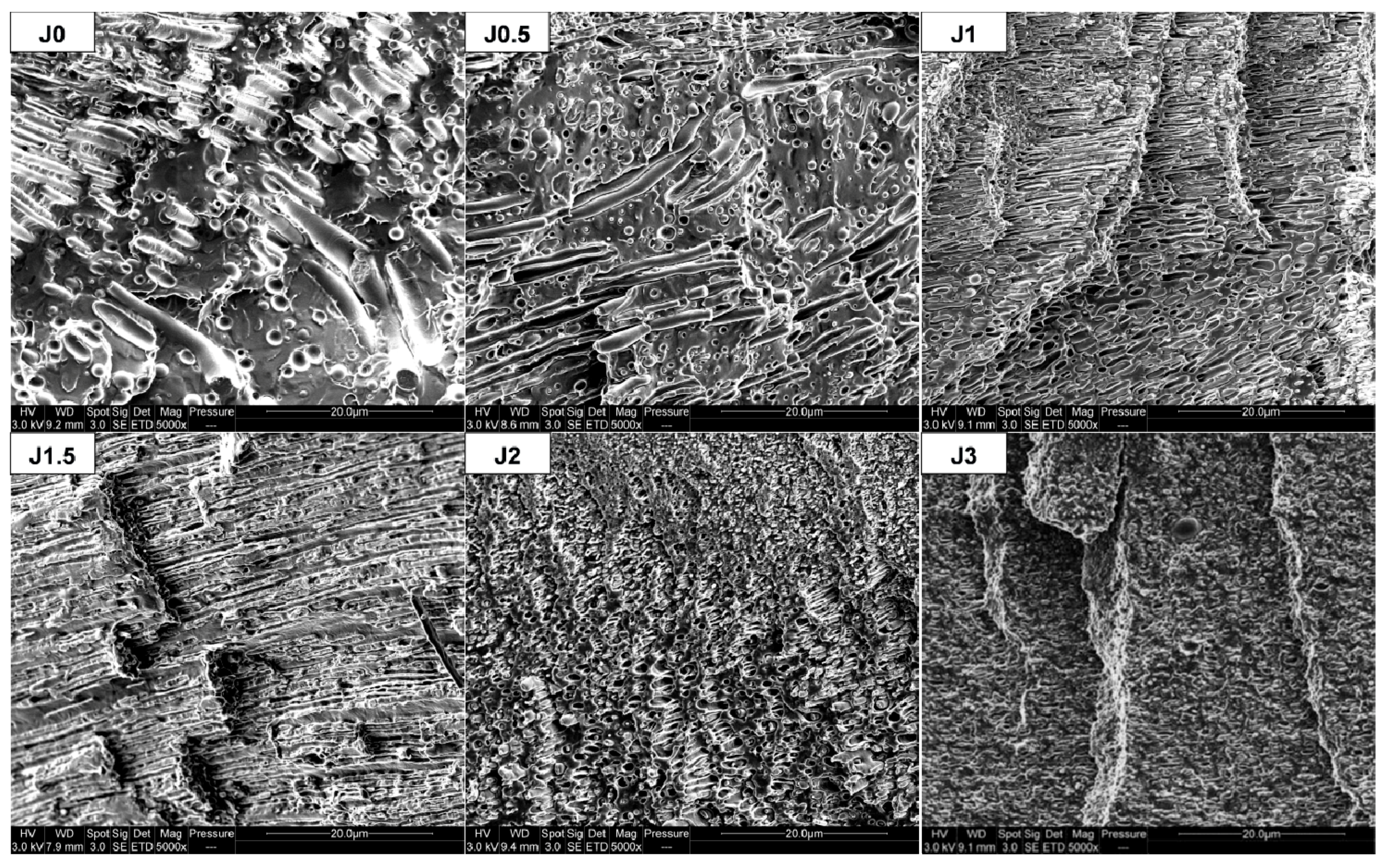


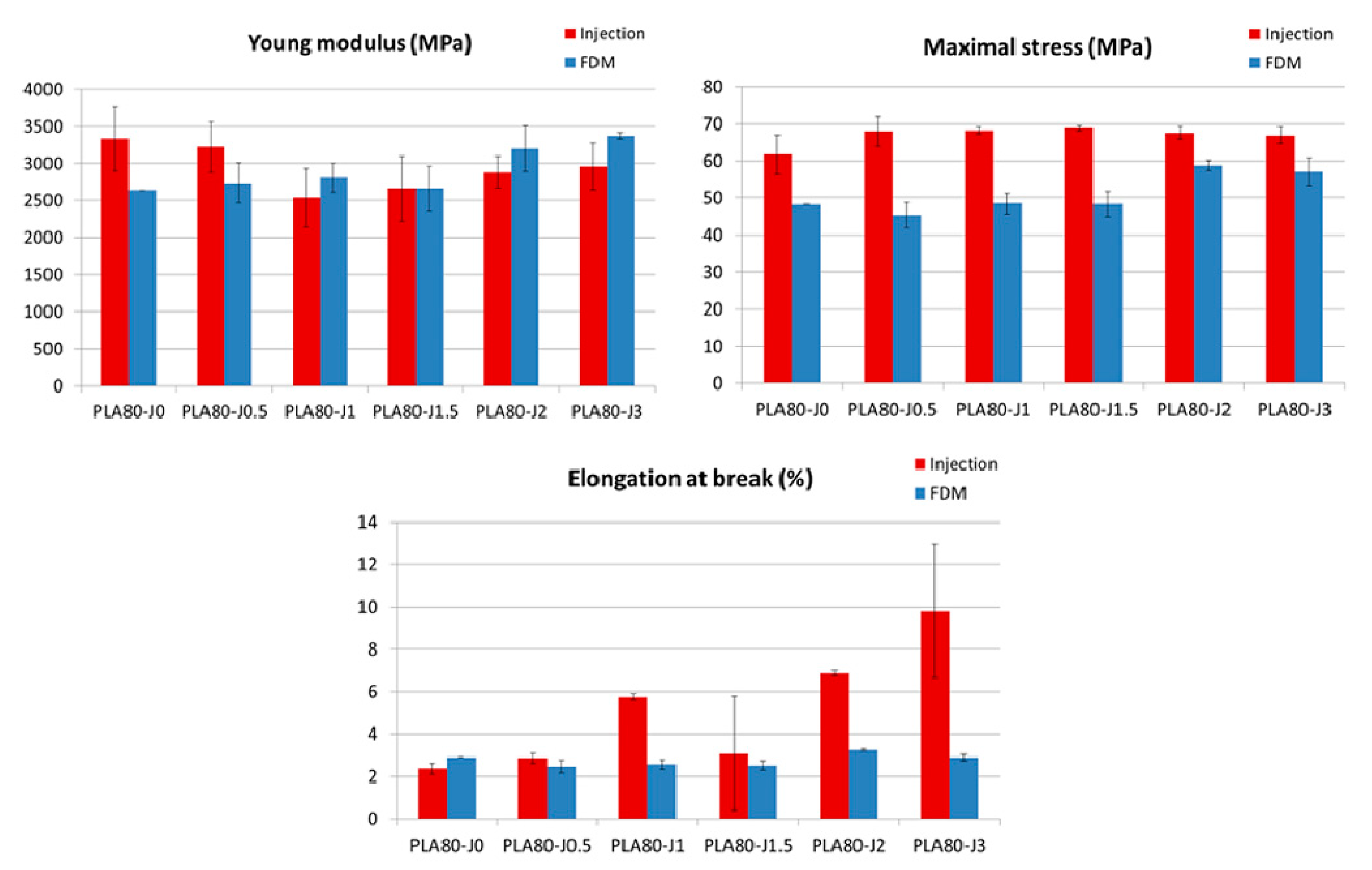
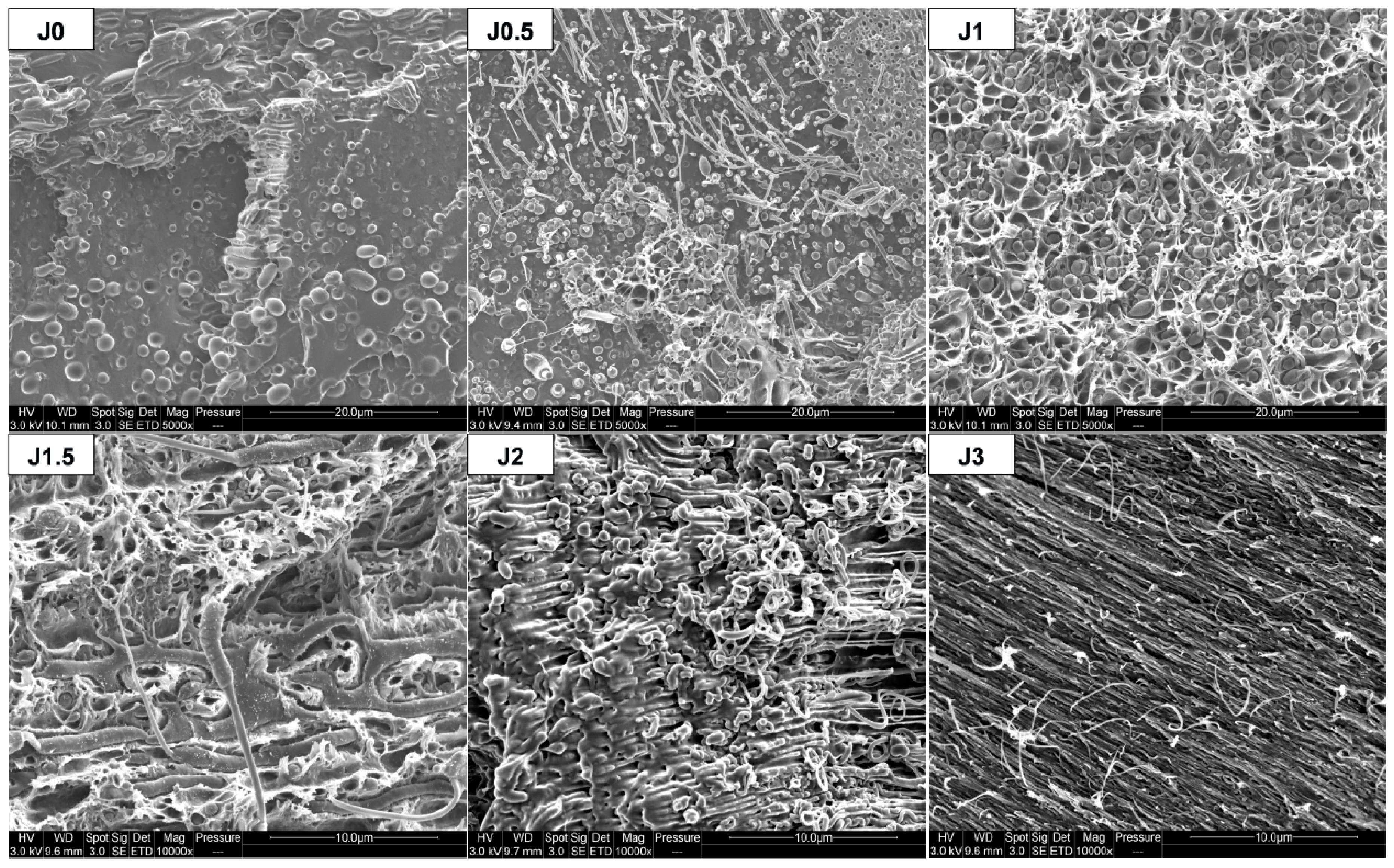

| Material | Density (g/cm3) | Tg (°C) | Tcc (°C) | Tm (°C) |
|---|---|---|---|---|
| PLA | 1.24 | 59 * | 101 * | 170 * |
| PA11 | 1.02 | - | - | 190 * |
| Joncryl | 1.08 | 54 | - | - |
| Samples | Tg PLA (°C) | Tcc PLA (°C) | ΔHcc PLA (J/g) | Tcc2 PLA (°C) | ΔHcc2 PLA (J/g) | Tm PLA (°C) | ΔHm PLA (J/g) | Tm PA11 (°C) | ΔHm PA11 (J/g) | Xc PLA (%) | Xc PA11 (%) |
|---|---|---|---|---|---|---|---|---|---|---|---|
| PLA | 59 | 101 | 32.7 | 156 | 1.6 | 170 | 40.4 | - | - | 6.9 | - |
| PLA-J4 | 59 | 104 | 26.3 | 152 | 0.4 | 166 | 30.6 | - | - | 4.3 | - |
| PA11 | - | - | - | - | - | - | - | 193 | 49.2 | - | 24.6 |
| PLA80-J0 | 60 | 98 | 18.0 | 155 | 2.6 | 170 | 34.7 | 190 | 8.9 | 22.4 | 22.2 |
| PLA80-J0.5 | 60 | 101 | 21.7 | 155 | 1.6 | 169 | 29.9 | 190 | 9.4 | 11.0 | 23.6 |
| PLA80-J1 | 60 | 106 | 21.7 | - | - | 168 | 24.4 | 189 | 9.1 | 3.6 | 23.0 |
| PLA80-J1.5 | 60 | 107 | 22.4 | - | - | 167 | 23.5 | 189 | 9.4 | 1.6 | 23.8 |
| PLA80-J2 | 61 | 108 | 21.7 | - | - | 168 | 23.6 | 190 | 8.9 | 2.6 | 22.7 |
| PLA80-J3 | 60 | 109 | 22.8 | - | - | 168 | 23.9 | 189 | 8.2 | 1.6 | 21.2 |
| Samples | Porosity (%) | Absolute Density (g/cm3) | ||||
|---|---|---|---|---|---|---|
| PLA80-J0 | 9.91 | ± | 0.29 | 1.1981 | ± | 0.0007 |
| PLA80-J0.5 | 16.66 | ± | 2.61 | 1.1986 | ± | 0.0033 |
| PLA80-J1 | 19.93 | ± | 0.60 | 1.2006 | ± | 0.0015 |
| PLA80-J1.5 | 17.19 | ± | 6.48 | 1.2026 | ± | 0.0003 |
| PLA80-J2 | 7.47 | ± | 4.90 | 1.1974 | ± | 0.0007 |
| PLA80-J3 | 12.86 | ± | 0.37 | 1.1945 | ± | 0.0057 |
© 2019 by the authors. Licensee MDPI, Basel, Switzerland. This article is an open access article distributed under the terms and conditions of the Creative Commons Attribution (CC BY) license (http://creativecommons.org/licenses/by/4.0/).
Share and Cite
Rasselet, D.; Caro-Bretelle, A.-S.; Taguet, A.; Lopez-Cuesta, J.-M. Reactive Compatibilization of PLA/PA11 Blends and Their Application in Additive Manufacturing. Materials 2019, 12, 485. https://doi.org/10.3390/ma12030485
Rasselet D, Caro-Bretelle A-S, Taguet A, Lopez-Cuesta J-M. Reactive Compatibilization of PLA/PA11 Blends and Their Application in Additive Manufacturing. Materials. 2019; 12(3):485. https://doi.org/10.3390/ma12030485
Chicago/Turabian StyleRasselet, Damien, Anne-Sophie Caro-Bretelle, Aurélie Taguet, and José-Marie Lopez-Cuesta. 2019. "Reactive Compatibilization of PLA/PA11 Blends and Their Application in Additive Manufacturing" Materials 12, no. 3: 485. https://doi.org/10.3390/ma12030485
APA StyleRasselet, D., Caro-Bretelle, A.-S., Taguet, A., & Lopez-Cuesta, J.-M. (2019). Reactive Compatibilization of PLA/PA11 Blends and Their Application in Additive Manufacturing. Materials, 12(3), 485. https://doi.org/10.3390/ma12030485





